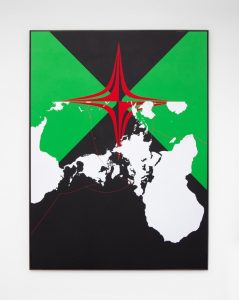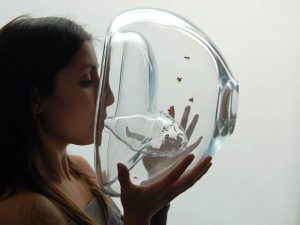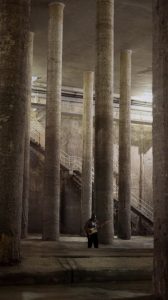The Pixelache Helsinki festival which closed on Sunday had programmed plenty of exhibitions. My favourite was Anisotropics, a series of projects by Shaina Anand and Ashok Sukumaran.
Like everyone involved in media art, I knew of Ashok Sukumaran’s work. In 2007 his project Park View Hotel was awarded the Golden Nica for Interactive Art at Prix Ars Electronica. He went on to receive numerous other awards and has exhibited around the world. The Pixelache exhibition offered me the first opportunity to see several works by Anand and Sukumaran together in a same space. While looking at the videos and photo documentation of their projects side by side, i realized how remarkably consistent and intelligent their work is.
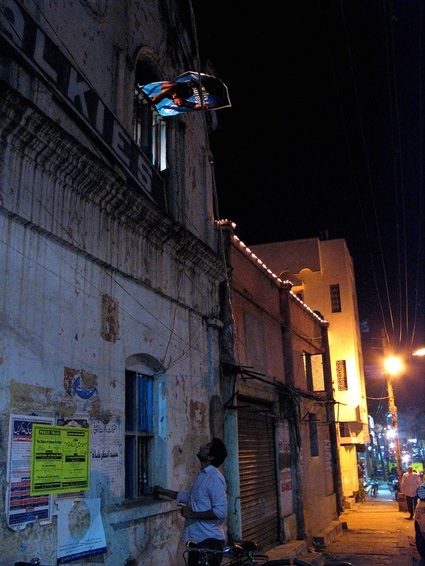 Changes of States, 2005
Changes of States, 2005
The exhibition title refers to anisotropy, the property of materials or mediums being direction-dependent. Crystals, wood and tendons for example are anisotropic, they show different strengths when pulled in different directions. Anand’s and Sukumaran’s work suggests that technology can follow paths different from the ones imposed by a purely capitalist perspective. When radio, electricity or CCTV is “pulled” in this way, it reveals a different set of properties, a vivid materiality and expanded parameters.
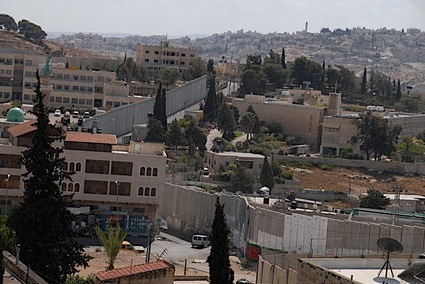 (Al jaar qabla al dar) The Neighbour Before the House, 2009
(Al jaar qabla al dar) The Neighbour Before the House, 2009
If i had to single out a work in the exhibition it would be (Al jaar qabla al dar) The Neighbour Before the House.
This series of video probes into the landscape of East Jerusalem, shot with a fixed security camera. The artists were sitting together with Palestinian residents in East Jerusalem as they commented the scenes captured by the camera. Some of them have had their house confiscated without much warning nor justification and they explain how happy they used to be in a house now occupied by settlers, others are quietly pointing out the changes that the topography of the city had to undergo over the past few years. The resulting video which was screened inside the gallery is a bit raw but it is also the most moving film i’ve seen recently. The idea behind the project is simple but the effect goes far beyond anything you could expect. Camera pans, zooms and live commentary become ways in which Palestinian residents reach out to what can be seen from their homes, and speak about the nature of their distance from others. (a project by CAMP).
The Neighbour Before the House is not the artists’ first foray into the surveillance systems. A few years ago already, Shaina Anand’s project KhirkeeYaan put security devices at the disposal of the audience, allowing them to interact with each other.
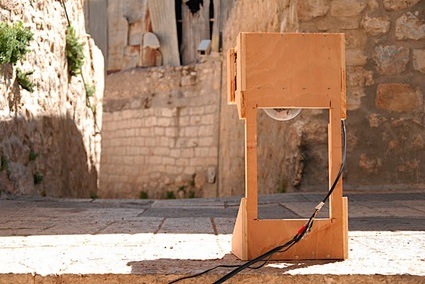 (Al jaar qabla al dar) The Neighbour Before the House, 2009
(Al jaar qabla al dar) The Neighbour Before the House, 2009
I caught up with Ashok and asked him a couple of questions about (Al jaar qabla al dar) The neighbour before the house:
Turning the surveillance camera on the one who are usually the one responsible for the surveillance is a very strong idea. Did you have to buy a new camera? or did you manage to get your hands on a model similar or identical to the one used by the Israeli?
The turning around of the surveillance system is a starting point, for the project. It is something that, in Shaina’s work in expanded film and in CAMP‘s visual projects more generally… is a given. I.e. that there are going to be many different ways to produce and retrieve moving images. The “general economy” of images is then a much larger and more interesting area than just auteur film, or commercial film, or art, etc.
When we enter this space, we are: a) working with standard equipment, that is not only “repurposed” but that reveals the dynamics and intentions of the system, and what drives its “use”. This is a much more interesting interpretation of something than the word “hacking” implies.
So in these cctv cameras, we can sense how the design of the pan/ tilt system, and the extreme zooms (250x) are integral to its imagined function. The camera used is a standard dome pan/ tilt camera, used generically around the world. It doesn’t matter so much where it came from, it is quite everyday and universal. It is used routinely, in many airports, etc. It costs about 400 dollars, about the same as a consumer handycam.
In the 2nd episode in jaar, there is a scene where the speaker points to a camera set up by the Isrealis in a street, that a guy on a bike had pulled of the wall. This camera isn’t that one, just to be clear :)
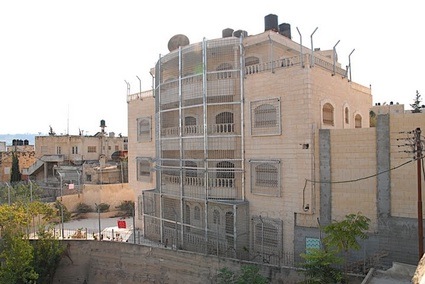 (Al jaar qabla al dar) The Neighbour Before the House, 2009
(Al jaar qabla al dar) The Neighbour Before the House, 2009
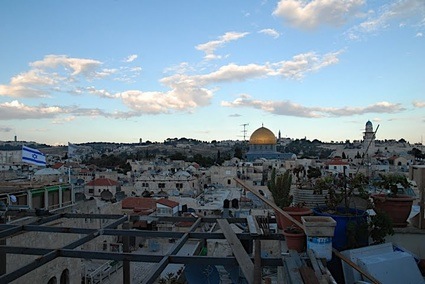 (Al jaar qabla al dar) The Neighbour Before the House, 2009
(Al jaar qabla al dar) The Neighbour Before the House, 2009
How easy was it for you to go back and forth between east Jerusalem and the rest of the city?
We were staying in East Jerusalem, and the work was part of the Jerusalem Show, held in the Christian quarter and in other places, curated by Jack Persekian and Nina Montmann. We never actually engaged with west Jerusalem. Moving around was not so difficult. We were stopped a couple of times, but that was it. And we weren’t doing anything really, just moving equipment around. Things are different every week, of course, and these past few weeks have been quite tense in Al Quds.
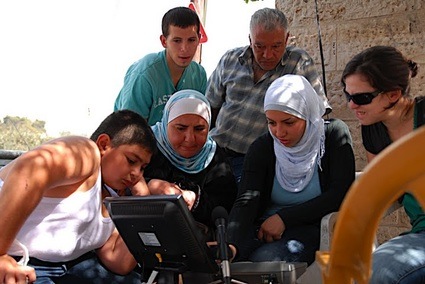 (Al jaar qabla al dar) The Neighbour Before the House, 2009
(Al jaar qabla al dar) The Neighbour Before the House, 2009
How did you select the people who commented on the images you shot? was there a strategy? people living at a certain distance of a separation wall for example?
The people were found in different ways. They did not comment on the images afterwards, it happened in sync with the shooting… i.e. the speaker was also manipulating the camera. Which is why you get this strange asynchronicity. The story is looking for an image, an image giving rise to a story.
There were some people close to the wall obviously, since the wall is everywhere. But one of the more poignant ones is where people are talking about their own house.. i.e. the house they lived in for decades, before they were evicted a few months ago, this is in Sheikh Jarrah.
Looking into your own house from outside, seeing strangers inside, their clothes drying on the roof, their changes to your garden, and their neglect of the lemon tree in the yard, all of this can be quite heart-wrenching.
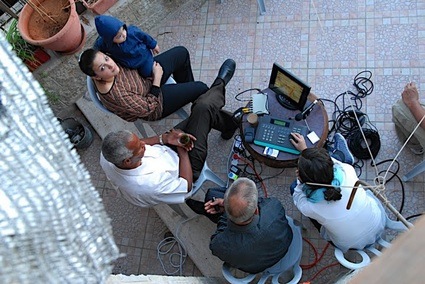 (Al jaar qabla al dar) The Neighbour Before the House, 2009
(Al jaar qabla al dar) The Neighbour Before the House, 2009
The webpage of the project says “The project is ongoing.” Do you have plan to work further on it? to develop it in other directions?
Yes, the project is being developed as a larger project. But we will keep publishing it in various ways. The videos you saw are one way. The other form this takes is raw footage on pad.ma:
Which also a project we work on, but the link is:
http://pad.ma/Vs7c6mni/00:00:06.000-00:00:39.000
(Use firefox or google chrome. )
You can download and reuse this material. You can even mark in and out and download parts of it (go to actions/ download this selection) And of course you can write your own commentary.
Do register on pad.ma so you can follow this project that way.
Thanks Ashok!
Anisotropics is part of the Signals from the South, an annual showcase of projects from ‘the South’ (South America, Africa, Asia) consisting of an exhibition and a seminar.
If you happen to be in Beirut next month, don’t miss Don’t Wait for the Archive. Archiving practices and futures of the image, a workshop and colloquium with pad.ma. The event takes place on Sunday, April 25th at Home Works, Beirut.


